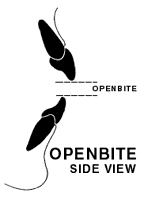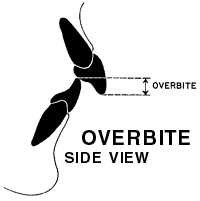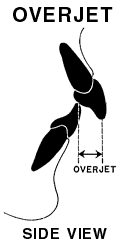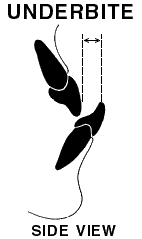Orthodontic Disorders
Crossbite
Crossbite can occur in the front and/or the sides of the mouth: One or more upper teeth bite on the inside of the lower teeth. This can occur with a single tooth or multiple teeth. Early correction of crossbite is recommended.
Crossbite should be corrected because it can:
- cause premature wear of the teeth
- cause gum disease including bone loss
- cause asymmetrical development of the jaws
- cause dysfunctional chewing patterns
- make your smile less attractive




How can a crossbite be orthodontically corrected?
If there is a single tooth crossbite, the tooth can be moved with braces into the correct position. In some cases, a retainer can be utilized. With multiple teeth in crossbite, the arch needs to be expanded with braces or other intra-oral appliances.
Openbite
Openbite is an insufficient vertical overlap of the teeth. It is caused by oral habits such as tongue thrust, digit sucking or when the jaws don’t grow evenly. Timing of treatment is critical to the overall success of the therapy.

How can an openbite be orthodontically corrected?
Openbite can be corrected through growth modification of the jaws using braces, extrusion of the anterior teeth and in some cases surgical correction of the jaws. Also breaking oral habits, such as digit sucking, will facilitate the correction of an openbite.


Overbite
Class II Overbite
Overbite occurs when the upper front teeth protrude over the lower front teeth. Generally there is no contact between the upper and lower front teeth. Often you cannot see the lower incisors. Overbite is due to a disproportionate amount of eruption of front teeth or over development of the bone that supports the teeth and a front to back discrepancy in the growth of the upper or lower jaw (Class II Relationship). Overbite is also known as a deep bite.

Overbite should be corrected because it can:
- cause improper functioning of your front teeth
- result in the lower front teeth biting into the gum tissue of the upper palate leading to tissue problems
- unusual wear of the lower front teeth
- cause jaw or joint problems
- make your smile less attractive


How can overjet be orthodontically corrected?
Overjet can be corrected through growth modification using a functional appliance and/or elastics to reduce the skeletal imbalance or extraction of teeth.
Overjet
Class II Overjet
Overjet is also known as protrusion. In this case, the lower teeth are too far behind the upper front teeth. This can be caused by an improper alignment of the molars (Class II Relationship), a skeletal imbalance of the upper and lower jaw; flared upper incisors, missing lower teeth or a combination of all the above. In addition, oral habits such as thumb sucking, finger sucking or tongue thrusting can exacerbate the condition.

Overjet should be corrected because it can:
- prevent proper functioning of the front teeth
- lead to premature wear
- make your smile less attractive


How can overjet be orthodontically corrected?
Overjet can be corrected through growth modification using a functional appliance and/or elastics to reduce the skeletal imbalance or extraction of teeth.
Underbite
Class III Underbite
The lower teeth protrude past the front teeth. An underbite is usually caused by undergrowth of the upper jaw, overgrowth of the lower jaw, or a combination of the two (Class III Relationship). Underbite can also be caused by flared upper incisors, missing lower teeth or a combination of all the above. Early correction of underbite is recommended.

Underbite should be corrected because it can:
- prevent proper functioning of the front teeth or molars which can lead to premature wear of the teeth
- cause chewing or eating problems
- cause jaw or joint problems
- make your smile less attractive


How can an underbite be orthodontically corrected?
Underbite can be corrected through growth modification of the jaws, extraction of teeth and in some cases, surgical correction of the jaws.
